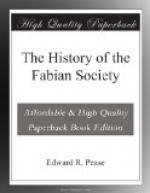Then came the War. The Labour Party Conference of 1915 did not take place, and a sudden new divergence of opinion arose in the Socialist movement. The Labour Party, the Fabian Society, and the leaders of the B.S.P. gave general support to the Government in entering into the war. The I.L.P. adopted an attitude of critical hostility. Amidst this somewhat unexpected regrouping of parties, any attempt to inaugurate a United Socialist Council was foredoomed to failure. The project for Socialist Unity therefore awaits the happy time when war shall have ceased.
FOOTNOTES:
[39] The Labour Party Conference held in January, 1916, unanimously accepted the affiliation of the British Socialist Party.
Chapter XI
The Minority Report, Syndicalism and Research: 1909-15
The emergence of Mrs. Sidney Webb—The
Poor Law Commission—The
Minority Report—Unemployment—The
National Committee for the
Prevention of Destitution—“Vote
against the House of Lords”—Bernard
Shaw retires—Death of
Hubert Bland—Opposition to the National
Insurance Bill—The Fabian
Reform Committee—The “New Statesman”—The
Research Department—“The
Rural Problem”—“The Control
of
Industry”—Syndicalism—The
Guildsmen—Final Statistics—The
War.
A former chapter was entitled “The Episode of Mr. Wells.” The present might have been called “The Intervention of Mrs. Sidney Webb,” save for the fact that it would suggest a comparison which might be misleading.
I have insisted with some iteration that the success of the Society, both in its early days and afterwards, must be mainly attributed to the exceptional force and ability of the Essayists. Later in its history only two persons have come forward who are in my opinion entitled in their Fabian work to rank with the original leaders, to wit, Mr. Wells and Mrs. Webb. Of the former I have said enough already. The present chapter will be largely devoted to the influence of the latter.
[Illustration: MRS. SIDNEY WEBB, IN 1909]
It must however be observed that in all their achievements it is impossible to make a clear distinction between Mrs. Webb and her husband. For example, the Minority Report of the Poor Law Commission, shortly to be dealt with, purported to be the work of Mrs. Webb and her three co-signatories. In fact the investigation, the invention, and the conclusions were in the fullest sense joint, although the draft which went to the typist was in the handwriting of Mr. Webb. On some occasions at any rate Mrs. Webb lectures from notes in her husband’s eminently legible handwriting: her own—oddly unlike her character—is indecipherable without prolonged scrutiny even by herself. Sometimes, on the other hand, it is possible to separate the work of the two. Mrs. Webb, although elected




